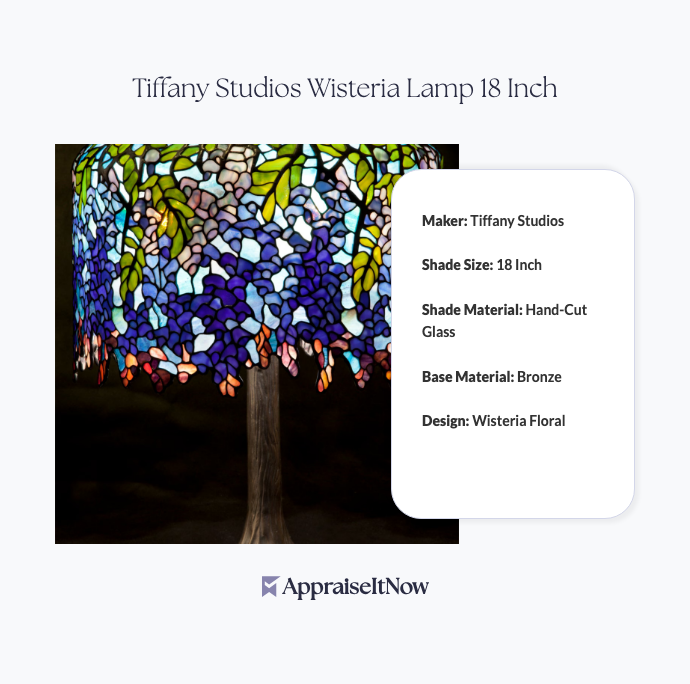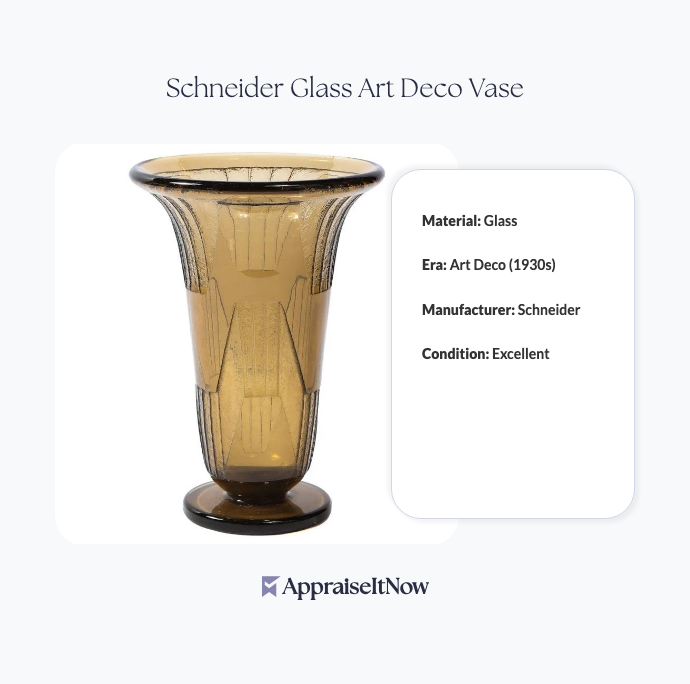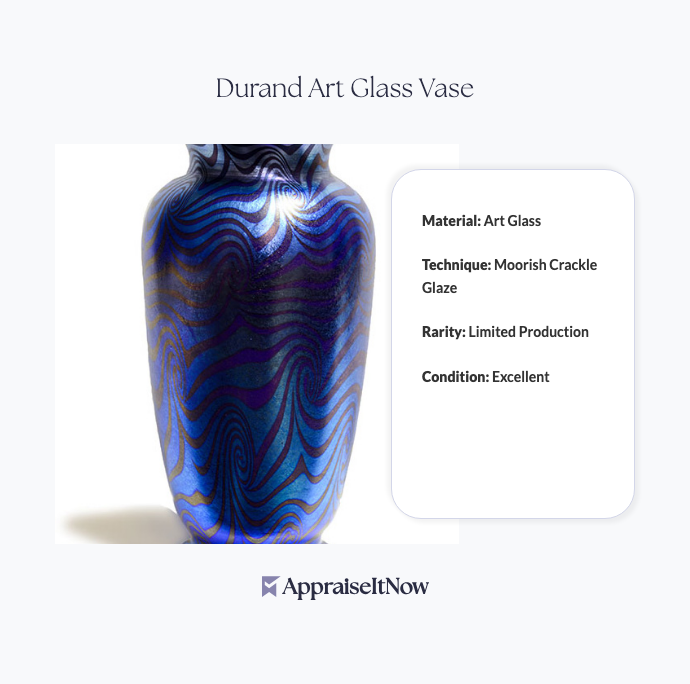<h1>How to Get Your Tiffany Studios Wisteria Lamp 18 Inch Appraised</h1>
<p>The Tiffany Studios Wisteria Lamp 18 Inch represents one of the most coveted pieces of American decorative arts, commanding estimated values between <strong>$35,000 and $45,000</strong> in today's collector market. Whether you've inherited this iconic fixture, discovered one at an estate sale, or are considering acquisition, understanding how to properly appraise and value your lamp ensures you make informed decisions about this significant investment.</p>
<h2>Understanding Your Tiffany Studios Wisteria Lamp's Value</h2>
<p>Your Tiffany Studios lamp occupies a unique position in the antique lighting market. First introduced in 1900, this design represents the height of the Art Nouveau movement when Louis Comfort Tiffany revolutionized decorative lighting through hand-cut glass and bronze craftsmanship. The 18-inch shade size delivers what collectors describe as a "stately presence," larger than smaller parlor lamps yet more manageable than monumental floor models that command six-figure valuations.</p>
<div class="callout tip"><p><strong>Collector's Insight</strong></p>
<p>The Wisteria pattern's floral motif draws inspiration from nature, featuring intricately arranged glass pieces that create depth and luminescence when illuminated—a hallmark of Tiffany's artistic vision.</p></div>
<p>The current market for Tiffany lamps demonstrates sustained strength, with quality examples maintaining values or appreciating modestly year over year. Unlike speculative contemporary art, Tiffany Studios pieces benefit from established provenance, documented production histories, and a century of consistent collector interest. When considering whether <a href="/types/memorabilia-and-collectibles">memorabilia and collectibles</a> represent sound acquisitions, Tiffany lamps consistently outperform broader antique categories.</p>
<h2>Key Factors Determining Your Lamp's Specific Value</h2>
<p>Several characteristics directly impact where your Wisteria lamp falls within the <strong>$35,000-$45,000</strong> range. Production records indicate Tiffany Studios produced just <strong>500 examples</strong> of this design worldwide, and surviving verified specimens number significantly lower. This scarcity fundamentally supports valuations and distinguishes authentic examples from later reproductions.</p>
<p><strong>Authenticity and Documentation</strong> form the foundation of appraisal value. Your lamp requires verification of several elements: the bronze base must carry proper Tiffany Studios markings, the glass shade should display characteristic Tiffany glass composition with appropriate aging patina, and ideally you possess documentation of the lamp's provenance. Authenticated pieces with clear ownership histories command premium valuations, while examples lacking documentation may appraise at the lower end despite identical physical characteristics.</p>
<p>The <strong>condition of the glass shade</strong> directly correlates with market value. Original glass retains slight haziness and subtle color variations that distinguish authentic aged glass from reproduction pieces. Even hairline fractures that don't compromise structural integrity require disclosure during appraisal, as professional assessors document all visible wear. Similarly, the bronze base's patina tells its age story—unnaturally bright or overly cleaned bases suggest inappropriate restoration, potentially reducing value by 15-20%.</p>
<div class="callout note"><p><strong>Valuation Reality</strong></p>
<p>Two Wisteria lamps of identical size and design pattern can appraise at dramatically different values (potentially $10,000+ apart) based solely on condition, provenance documentation, and rarity of their specific production year.</p></div>
<h2>What Makes Tiffany Studios Different From Tiffany-Style Lamps</h2>
<p>A fundamental distinction affects your lamp's value dramatically: authentic Tiffany Studios production versus "Tiffany-style" reproductions created decades later. This confusion explains why some sellers mistakenly believe their lamps worth significantly more (or less) than actual market value.</p>
<p>Genuine Tiffany Studios lamps feature <strong>hand-cut glass</strong> individually fitted into lead came channels, creating slight irregularities in fitting and subtle variations in glass color saturation. Reproduction "Tiffany-style" lamps, manufactured from the 1920s onward and continuing today, typically employ molded glass pressed into uniform patterns. When examining your lamp, authentic examples display where individual artisans adjusted glass pieces to fit the bronze framework—authentic Tiffany work shows human intervention in the assembly process.</p>
<p>The base construction also reveals authenticity. Original Tiffany Studios bronze bases contain marks stamped directly into the metal, typically reading "TIFFANY STUDIOS NEW YORK" with a production number. Reproduction bases may bear these markings but lack the precise quality of original foundry work, detectable through weight, patina consistency, and base hardware proportions. Understanding these distinctions proves essential when seeking <a href="/types/antique-artwork">antique artwork</a> and <a href="/types/antique-furniture">antique furniture</a> appraisals, where authentication directly determines whether your piece falls into the five-figure or low-four-figure category.</p>
<h2>The Critical Role of Tiffany Lamp Markings and Signatures</h2>
<p>When examining your Wisteria lamp for appraisal purposes, locating and documenting markings significantly impacts professional valuation. Authentic Tiffany Studios lamps carry identifying marks in specific locations. The <strong>bronze base</strong> typically displays "TIFFANY STUDIOS" cast or stamped into the metal, along with a production number. The <strong>glass shade</strong> often carries subtle markings, though determining their location and condition requires careful inspection.</p>
<p>Are all Tiffany lamps signed? Not consistently, particularly on glass shades where signatures sometimes appear on individual glass panels hidden within the assembled lamp. This reality means absence of visible markings doesn't necessarily indicate a reproduction—many authenticated pieces lack obvious signatures, requiring expert examination to establish authenticity. Professional appraisers specializing in Tiffany Studios work understand these nuances and possess comparative knowledge of marking variations across production years.</p>
<div class="callout tip"><p><strong>Appraisal Advantage</strong></p>
<p>When documenting your lamp for appraisal, photograph all visible markings from multiple angles in natural light. Close-up images of base stamps help appraisers begin authentication before in-person inspection.</p></div>
<h2>Market Demand and Collection Trends</h2>
<p>Understanding current collector interest helps contextualize your lamp's market position. The Wisteria pattern remains among Tiffany Studios' most recognizable designs, second only to perhaps the Dragonfly and Water Lily patterns in popular recognition. This visibility supports consistent demand from both seasoned collectors and newer enthusiasts discovering Tiffany works through museum exhibitions and estate discoveries.</p>
<p>Recent market activity indicates that Tiffany Studios lamps, particularly in the 18-inch size, experience steady collector interest with modest annual appreciation. Internet accessibility—where images of Tiffany lamps proliferate across auction sites and collector forums—has democratized awareness while simultaneously increasing competition among would-be purchasers. This creates a balanced market where authentic examples find buyers reliably, but extraordinary price appreciation requires exceptional rarity factors (such as documented celebrity ownership or museum-quality provenance).</p>
<p>When exploring <a href="/blog/how-to-get-an-accurate-antique-furniture-appraisal">how to get an accurate antique furniture appraisal</a> principles apply similarly to decorative lighting—market knowledge, condition assessment, and comparative analysis drive valuations. The sustained appeal of Tiffany Studios work reflects both aesthetic enduring quality and the emotional connection collectors maintain to these luminous artworks.</p>
<h2>Finding and Selecting an Appraiser for Your Tiffany Lamp</h2>
<p>Obtaining accurate professional appraisal for your <strong>$35,000-$45,000 investment</strong> requires selecting an appraiser with demonstrated expertise in Tiffany Studios glass and <a href="/types/household-goods">antique lighting</a>. Generalist appraisers, while certified, may lack the specialized knowledge necessary to authenticate glass composition, identify production variations, or recognize reproduction characteristics visible only to experienced eyes.</p>
<p>Look specifically for appraisers who maintain memberships in recognized organizations—the <strong>American Society of Appraisers (ASA)</strong> or <strong>International Society of Appraisers (ISA)</strong> provide credential verification, indicating formal training and adherence to appraisal standards. Request references from appraisers who've previously valued Tiffany Studios works, and ask whether they can provide comparative sales data supporting their valuation conclusions. Understanding <a href="/blog/the-basics-of-antique-furniture-appraisal">the basics of antique furniture appraisal</a> methodologies helps you evaluate whether your appraiser follows systematic, defensible approaches to value determination.</p>
<p><strong>AppraiseItNow</strong> connects you with <strong>USPAP-compliant appraisers</strong> across the United States who specialize in decorative arts and antique lighting. Our certified experts understand the nuanced factors affecting Tiffany Studios valuations and provide detailed reports suitable for insurance, sale documentation, or estate planning purposes. When you submit photographs and descriptions through our secure platform, our specialists conduct thorough appraisals backed by comparative market analysis and authentication expertise.</p>
<div class="callout tip"><p><strong>Professional Advantage</strong></p>
<p>Appraisers credentialed through established organizations maintain continuing education requirements, ensuring current market knowledge and authentication methodology that updates as reproductions become more sophisticated.</p></div>
<h2>Valuation Methods and Comparable Sales Data</h2>
<p>Your appraiser establishes the <strong>$35,000-$45,000 range</strong> through systematic comparison to recent comparable sales. This approach examines auction results, private sales (when documented), and dealer asking prices for similarly sized Tiffany Studios Wisteria lamps. Comparable sales analysis provides market-defensible support for appraisal value—essential documentation if insurance claims or legal disputes require justification of valuations.</p>
<p>The challenge in Tiffany lamp appraisal involves the relative scarcity of comparable transactions. Unlike mass-produced antiques, Tiffany Studios pieces appear in the market intermittently, sometimes with months or years between comparable sales. Professional appraisers maintain extensive databases of auction results, private transactions reported through collector networks, and dealer inventory tracking. This historical data allows specialists to identify market trends (such as whether collector preference shifts toward certain patterns or production years) and adjust valuations accordingly.</p>
<p>Documentation of your lamp's provenance—where it's been, who previously owned it, any published references to it—substantially influences appraisal value within the range. Lamps with established collector history or prior reputable auction sales command premium valuations. Conversely, lamps with unknown origins, while potentially valuable, appraise more conservatively due to authentication uncertainty.</p>
<h2>Preservation and Insurance Considerations</h2>
<p>Your Wisteria lamp represents both an aesthetic treasure and a fragile artifact requiring thoughtful stewardship. The hand-cut glass shade remains vulnerable to breakage, vibration damage, or environmental stress, while the bronze base may develop patina-altering corrosion in improper storage conditions. Proper care directly preserves your lamp's appraised value—preventable damage through negligent handling or display can reduce worth by thousands of dollars.</p>
<p>Store your lamp in a climate-controlled environment maintaining consistent temperature (ideally 65-75°F) and moderate humidity levels (40-50%), avoiding basements prone to moisture fluctuation or attics subject to temperature extremes. Display your lamp away from direct sunlight—prolonged UV exposure fades the glass colors and deteriorates patina. When repositioning or transporting your lamp, support both the shade and base independently, never relying on the fragile glass to bear weight.</p>
<p>Insurance documentation derived from your professional appraisal proves invaluable should damage occur. Your appraiser's detailed photographs and condition assessment establish baseline condition, while the valuation provides replacement cost documentation essential for insurance claims. When exploring <a href="/blog/how-to-properly-store-and-maintain-your-memorabilia-and-collectibles">how to properly store and maintain memorabilia</a>, specialists emphasize that appraisal documentation serves as your record of what existed and in what condition—protecting your interests should loss occur.</p>
<div class="callout note"><p><strong>Key Takeaway</strong></p>
<p>A certified appraisal of your Tiffany Studios Wisteria Lamp 18 Inch provides essential documentation for insurance protection, authentication verification, and confident decision-making regarding this significant decorative arts investment. Professional appraisers ensure your lamp's true market value receives accurate assessment, supporting both its preservation and your financial interests.</p></div>







.avif)







